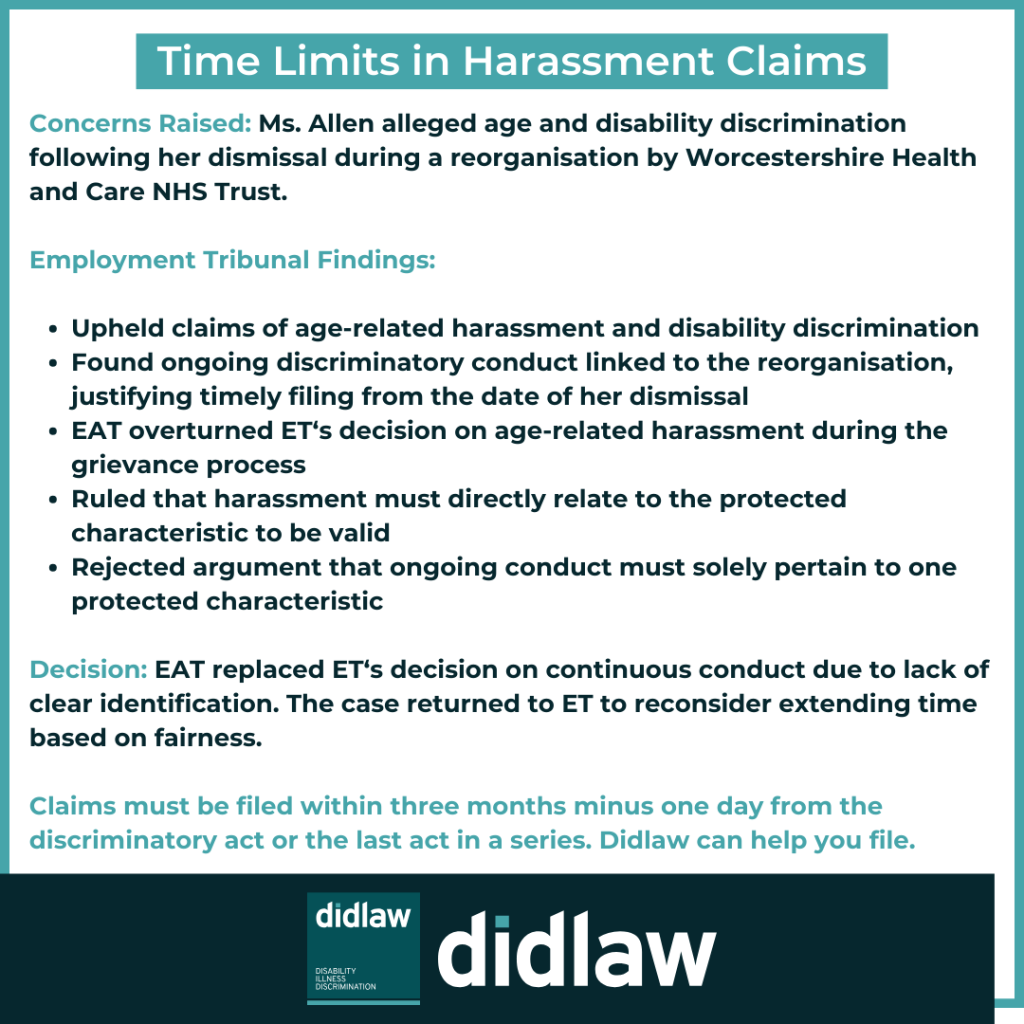
As most claimants discover, bringing discrimination and harassment claims can be complicated. Worcestershire Health and Care NHS Trust v Allen is a case, where the claimant’s win at tribunal was overturned by the Employment Appeal Tribunal (EAT) because it believed that the tribunal judge had got the law wrong with respect to two aspects of the claim: (1) whether the employer’s conduct in prejudging the outcome of the Claimant’s grievance constituted age-related harassment; and (2) whether the Claimant had brought her claims in time.
Let’s look at the relevant law. Harassment is defined by section 26 of the Equality Act 2010 as “unwanted conduct related to a relevant protected characteristic that has the purpose or effect of violating another person’s dignity or creating an intimidating, hostile, degrading, humiliating or offensive environment for that person.”
A claim must be started by notifying ACAS Early Conciliation of the employee’s intention to bring a tribunal claim within three months minus one day from the date of the act of discrimination/harassment or the date of the last act of discrimination/harassment where there has been conduct extending over a period of time.
If there has been a series of related acts of discrimination and/or harassment, the employee can use the date of the last act to calculate their time limit. If a claim is not filed in time, then a tribunal may extend the time limit if it has just and equitable reasons to do so.
In this case, the Trust undertook a reorganisation exercise. It informed Ms Allen that her job would cease to exist and offered her a role at a lower grade, which she rejected. She then went off sick and was eventually dismissed because of her ill-health absences. She brought a number of claims including claims for age and disability discrimination.
The tribunal upheld some of her claims. It found that the decision of her line manager to tick a box on a medical form asking Occupational Health to comment on her retirement due to ill health and the Trust’s conduct in predetermining the outcome of her grievance amounted to age-related harassment. It also held that her dismissal, which took into account her disability-related absence, arose in consequence of disability and breached section 15 of the Equality Act.
The tribunal held that all three acts were intrinsically linked because they arose from the Trust’s reorganisation – conduct extending over a period of time – and which were all brought in time because the Claimant had filed her claim within three months minus one day of the date of the last act of discrimination – the act of her dismissal.
The Trust appealed against the tribunal’s finding of age-related harassment in relation to the Claimant’s grievance and its conclusion that there was conduct extending over a period.
In relation to the Claimant’s grievance, the EAT held that the conduct must be related to the protected characteristic to succeed in a harassment claim. The EAT held that it will generally be necessary to consider the mental process of the person who dealt with the grievance to determine if they harassed the employee. The EAT concluded that the only connection the tribunal had found between the Claimant’s age and the grievance process was that the grievance included an allegation of age discrimination.
However, it was the prejudgment of the grievance that constituted the conduct that had to be related to age. They noted that there was no use of ageist language that could have resulted in a conclusion that the prejudgment of the grievance inherently involved age discrimination. Nor had the tribunal identified anything that connected the prejudgment of the grievance to her age. The EAT therefore rejected this complaint.
The EAT rejected the Trust’s submission that conduct extending over a period must all relate to the same protected characteristic. This is not the case. It gave the example of a person who made sexist and/or racist comments to a woman. The EAT could see nothing in the language of the relevant statutory provisions that would prevent the entire course of the racist and sexist behaviour constituting conduct extending over a period.
Similarly, there was no reason why conduct extending over a period cannot involve a number of different types of prohibited conduct, such as a mixture of harassment and direct discrimination. It may be more difficult to establish that there has been discriminatory conduct extending over a period where the acts that are said to be linked relate to different protected characteristics and different types of prohibited conduct, but there is no absolute bar that prevents there being conduct extending over a period in such circumstances.
The tribunal found that the events were linked because they all arose in the course of the implementation of the restructure. The EAT noted that those who decided to dismiss the Claimant were not involved with the decision to tick the ill-health retirement box. There was a substantial gap between these ticking the box and the dismissal and they involved different types of prohibited conduct, different protected characteristics and decisions by different people.
While none of these factors precluded the possibility of there being conduct extending over a period, it would have been necessary for the tribunal to clearly identify what the continuing discriminatory conduct was. As the tribunal did not identify anything that could establish a continuing series of acts, the EAT substituted a finding (reversed the decision of the original tribunal) and held that the two complaints that succeeded did not form part of conduct extending over a period.
The issue of whether time should be extended on just and equitable grounds needed to be considered instead and the case has been returned to the tribunal for further consideration.
If you would like to read the judgment, you can find it here.This blog was written by Anita Vadgama, Partner at didlaw.
